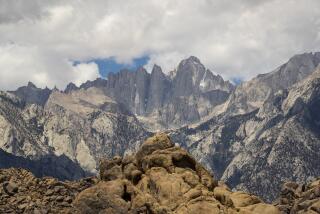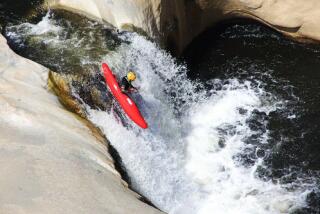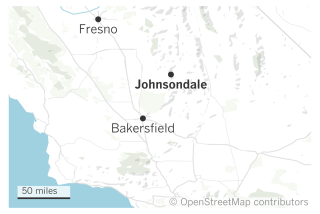Mt. Rainier, three hikers, killer storm
SEATTLE — They were close friends, two young couples enamored with the outdoors and intrepid when it came to the weather. By all accounts, they were familiar with the mountain, which here in the Pacific Northwest is more an icon -- a point of pride despite its sometimes deadly history.
Mt. Rainier often is shrouded by clouds. That was the case Monday morning when the four hikers parked their cars at the visitor center. The trail to Rainier’s summit begins at Paradise, at 5,400 feet. Eduard Burceag, 31, and Daniel Vlad, 34, both engineers, had climbed to the top before.
The men and their wives, Mariana Burceag, 31, and Julia Vlad, had planned to hike to Camp Muir -- a shelter and campsite 10,000 feet up the south side of the 14,410-foot volcano.
Under most conditions, the daylong excursion is neither easy nor treacherous. The two couples planned to finish by dusk and return home to their young children. But clouds and drizzle discouraged Julia Vlad from going on the trek.
The others then set off. But a ferocious storm, unusual for June, trapped them on the mountain overnight Monday, killing Eduard Burceag.
His wife and Daniel Vlad were transported off the mountain by military helicopter early Wednesday and treated for frostbite at Seattle’s Harborview Medical Center before being released.
Nothing about the conditions Monday morning could have foretold what the three hikers would face. Their ascent to Muir passed uneventfully, according to park officials, although the weather was less than perfect.
“The conditions were not unusual for the Northwest,” said Kevin Bacher, spokesman for Mount Rainier National Park. “Hiking in the rain is just what we do here.”
The trio took about six hours to hike the 4.5 miles up the Skyline Trail to Muir, which is roughly halfway between Paradise and the summit. After a brief rest, they began their descent, which normally takes about two hours.
David Gottlieb, the lead ranger who coordinated the rescue, gave this account of the hikers’ ordeal:
The group started down the mountain about 6:30 p.m., which this time of year gave them more than two hours of daylight. Light snow was falling; a steady wind was blowing.
Less than a mile into the descent, winds increased to 50 mph, gusting even higher. Heavy, wet snow started to fall as the temperature dropped into the 20s. The hikers were above the tree line, where there are few features to navigate by even when it is clear.
When the blizzard hit, they were blinded by a whiteout, the “type that can make you nauseous because you can’t tell what’s up or down,” Gottlieb said.
Disoriented, the group decided to dig a trench behind some rocks and take shelter. They were properly outfitted for a hike in the snow, but not to spend the night in a storm. They had gloves, hats, long underwear, boots, down coats. But they had no tents, no sleeping bags, no stove. They also had two-way radios and cellphones, which typically do not work very well -- if at all -- that high on the mountain.
Late Monday, Julia Vlad became concerned when the hikers had not returned home. She called a friend, who drove to Paradise and was able to talk to Daniel Vlad on the radios. About that time, 3:30 a.m. Tuesday, Vlad was able to make a 911 call on his cellphone, alerting park rangers.
A team was assembled at Camp Muir for the rescue effort. But without knowing exactly where to look, Gottlieb decided it was too dangerous to send the rangers and mountain guides out in the storm.
Sometime after making the emergency call, Vlad decided to leave his friends behind and start up the slope toward Muir. About 7 a.m., rescuers at the camp heard Vlad shouting and spotted him through binoculars. He was coherent but suffering the effects of hypothermia. They helped him into the shelter. On the verge of collapse, he pointed.
“My friends . . . they are just down there,” he said, describing a rock formation that made rescuers confident they knew where to find the missing hikers. It had to be Anvil Rock, they thought. It turned out the Burceags were only a half-mile from the camp. Kevin Hammond, a park ranger and a member of International Mountain Guides, reached the Burceags in less than 30 minutes.
“People have literally died within five minutes of the hut,” Gottlieb said. “In those conditions, you can’t see things 40 feet away.”
The wet snow had frozen on the Burceags, melted, and then refrozen in layers. They were soaked to the skin, Gottlieb said. Eduard Burceag was unconscious; he had no pulse. Mariana Burceag was suffering from severe frostbite to her feet but could move. The rescuers made the decision to carry her back to the camp and leave Eduard behind. Another wave of rescuers retrieved him within the hour.
Weather conditions were still too treacherous Tuesday for a helicopter to retrieve the hikers. Carrying them down the mountain would have meant more exposure to weather and cold. As it happened, three doctors were in the hut at Muir, waiting to attempt the summit. Two were emergency room physicians; one was an orthopedic surgeon. They agreed it was safer to keep the hikers in the hut, where there was propane heat, hot food, warm clothing and sleeping bags.
“If there’s anything to be learned from this,” said George Dunn, one of the operators of International Mountain Guides, “we hope that people understand the need to be prepared for emergencies.”
About 100 people have died on Rainier since 1887, the first year records were kept.
Wednesday afternoon, Eduard Burceag’s body was brought down to the parking lot at Paradise. Rangers wanted to transport his body by helicopter, but the weather was still too dangerous. So they carried him to the visitor center in a sled.
More to Read
Sign up for The Wild
We’ll help you find the best places to hike, bike and run, as well as the perfect silent spots for meditation and yoga.
You may occasionally receive promotional content from the Los Angeles Times.






